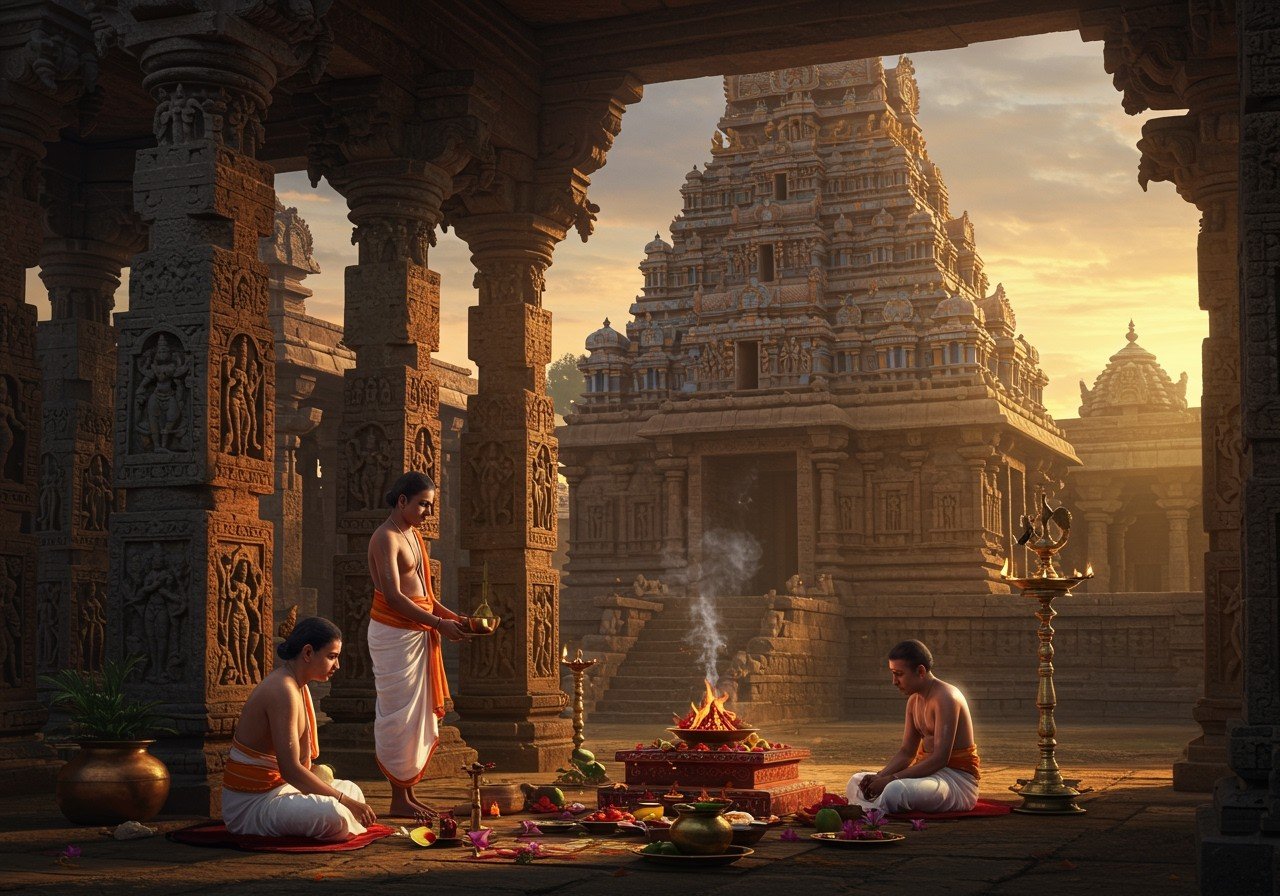
The Kadamba Dynasty, a prominent power in South India from the 4th to 6th centuries CE, left an enduring legacy of rich cultural heritage and significant contributions to art and architecture. Their religious beliefs and practices were deeply intertwined with their society and governance. This article delves into the key elements that defined the Kadamba Dynasty’s spiritual realm, including their deities, iconic temples, and unique religious practices.
Historical Overview
Founded by Mayurasharma, a Brahmin scholar, in the 4th century CE, the Kadamba Dynasty rapidly expanded its influence across the region. His successors adopted the surname Varma, signifying their Kshatriya status, reflecting their evolving socio-political identity. Kings like Kakusthavarma and Ravivarma played pivotal roles in the dynasty’s growth, skillfully merging Vedic traditions with local beliefs. Interactions with neighboring kingdoms further enriched their unique blend of cultural and religious practices.
Deities of the Kadamba Dynasty
The Kadamba Dynasty predominantly worshipped Lord Shiva and Lord Vishnu, adhering to both Shaivism and Vaishnavism. Lord Shiva, revered under epithets like Madhukeshwara, and Lord Vishnu, honored as Ananteshwara, held central positions in their spiritual life. Goddesses Durga and Lakshmi also received significant reverence. The worship of local deities and folk traditions further enriched their religious landscape. The rulers actively supported religious life through temple patronage and royal rituals, including the Ashwamedha (horse sacrifice).
Magnificent Kadamba Temples
Kadamba temples stand as architectural marvels, showcasing the dynasty’s artistic prowess and devotion. The Madhukeshwara Temple in Banavasi exemplifies their distinctive style, particularly the unique Kadamba Shikara (tower). These temples served as vital hubs of social and religious activity, hosting festivals, rituals, and community gatherings. The Kadamba rulers demonstrated their commitment to spiritual and social well-being by investing in temple construction and preservation.
Religious Practices and Rituals
Daily worship in the Kadamba Dynasty involved offerings, prayers, and elaborate ceremonies. Major festivals like Maha Shivaratri and Vaikuntha Ekadashi were celebrated with great enthusiasm. Pilgrimage sites flourished within the kingdom, fostering religious tourism. Priests and religious scholars played crucial roles in guiding spiritual practices and maintaining the sanctity of temples, ensuring the preservation of religious traditions. The practice of Sati, particularly among warrior classes, was also prevalent, believed to absolve the deceased husband’s sins.
Cultural Integration of Religion
Religion permeated Kadamba culture, influencing art, literature, and governance. Religious themes adorned sculptures, inscriptions, and paintings, enriching their artistic heritage. Hymns, epics, and other religious literature contributed to their cultural legacy. Religion and governance were closely intertwined, with rulers enacting religious policies. Royal patronage supported education and scholarly pursuits, further integrating religion into all aspects of life.
Enduring Legacy and Influence
The Kadamba Dynasty’s religious beliefs and practices left an indelible mark on South Indian culture, influencing later dynasties like the Chalukyas and Rashtrakutas. Their temples remain vital sites of worship and cultural activity. Ongoing efforts to preserve Kadamba heritage through modern initiatives and academic research underscore the dynasty’s enduring significance.
Kadamba Dynasty Religion: FAQs
What were the primary deities of the Kadamba Dynasty? The Kadamba dynasty primarily venerated Lord Shiva and Lord Vishnu, alongside Goddesses Durga and Lakshmi. Local deities and folk traditions also played a role in their religious practices.
What are some notable Kadamba temples? The Madhukeshwara Temple in Banavasi is a prime example of Kadamba architecture, showcasing their distinctive Shikara style. Other significant temples exist throughout their former territories.
What was the significance of temples in Kadamba society? Temples served as vibrant centers for religious rituals, festivals, and community gatherings, playing a vital role in the social fabric of the Kadamba kingdom.
How did religion influence Kadamba art and culture? Religious themes were prominently featured in Kadamba sculptures, inscriptions, paintings, and literature, reflecting the deep integration of spirituality into their cultural expression.
Poojn.in: Connecting You to the Spirit of the Kadamba Dynasty
Poojn.in, India’s leading online store for cultural and religious goods, offers a wide selection of items to support your spiritual practices, reminiscent of the reverence shown by the Kadamba Dynasty. Explore our collection of puja items, including copper and brass items for offerings, traditional incense and dhoop, puja thalis, and sacred items for Vishnu worship, all conveniently available online with delivery across India. Deepen your understanding of Hindu mythology and deities through our informative blog, featuring articles on Garuda, Lord Vishnu’s divine mount, and other significant figures like Lord Indra. Visit www.poojn.in today to discover more.
Further Exploration
-
Delve deeper into the concept of Karma with our insightful blog post: Karma in Hinduism.
-
Expand your knowledge of Hindu deities with our comprehensive guide: Hindu Gods and Goddesses.
-
Learn more about the significance of camphor in Hindu rituals and purchase high-quality camphor products here: Cycle Pure Camphor and Mangalam Camphor Tablets.
-
Enhance your puja experience with authentic agarbatti: Kushal Mangal Sandalwood Agarbatti.
-
Adorn your Laddu Gopal with beautiful attire and accessories: Laddu Gopal Brass Murti.


